How Driftwood Reshapes Ecosystems
In one of nature’s remarkable second acts, dead trees embark on transformative journeys
/https://tf-cmsv2-smithsonianmag-media.s3.amazonaws.com/filer/e0/06/e006bd4a-d2b1-41f9-89ff-d21c845ee103/c53mk6.jpg)
This article is from Hakai Magazine, an online publication about science and society in coastal ecosystems. Read more stories like this at hakaimagazine.com.
Logs the size of telephone poles drift along the shore of the Salish Sea. Erik Hammond turns the wheel of his aluminum skiff and closes in. He grabs his ax and towlines, then leaps atop the floating wood, much as his father did, and his father did before him. With the butt of his ax he drives anchor pegs into the choicest three and ties them to the stern. When he turns his boat, the lines go taut—the logs startle, then come to heel. Satisfied, he unties the lines and tosses them over before circling back to the beach. But the logs sail on, toward his partner, George Moore, who adds them to the growing haul already tied behind his skiff.
Hammond and Moore are beachcombers, or log salvors, based in Gibsons, British Columbia, a small coastal community less than 50 kilometers north of Vancouver. They are practitioners of an occupation once common on the Pacific Northwest coast. Moore, 72, has been chasing logs since he was a kid. Hammond, 41, was still in diapers when he started tagging along with his father. It’s a demanding and sometimes dangerous pursuit that calls for strength, balance, finesse, and a command of mechanics and physics. In return, it offers uncertainty and little pay.
“I love it,” Hammond declares. “It’s all I know how to do.”
On this calm summer afternoon, Hammond and Moore gather merchantable timber that has escaped log booms owned by logging companies. Once wood is floating free, it’s a hazard to navigation—and fair game for licensed log salvors. Today’s catch, mostly fir and cedar, will be sold through a cooperative that returns a share of the total value back to the logging companies. What’s left for Hammond and Moore averages CAN $25 per log—which they split. They’re also on the lookout for pristine, uncut trees that have ended up in the water through wind, erosion, or flood. With no logging company to lay a claim, this wood can fetch far more. They say the best time for beachcombing is during the fall and winter months, when high tides coincide with the arrival of powerful storms, which upset log booms and topple trees into swollen rivers and streams.
Be it clean sawlogs, twisted branches, or stumps with the rootball still attached—whether the result of industry or flood—driftwood is the remains of any tree that ends up washed ashore or floating in the sea. Beyond a dwindling number of beachcombers hoping to make a buck, and mariners wishing to avoid striking deadheads, why should anyone care?
Driftwood makes an enormous if underappreciated contribution to the food web connecting the forests and the sea. From streams to estuaries to the deep ocean floor, driftwood shapes every environment it passes through. While there’s an awareness that temperate rainforests are enriched with nitrogen from the marine environment, delivered by decomposing salmon, less well known is the fact that dead trees from those same forests travel to the sea and become a vital source of food and habitat. Driftwood is in need of a PR campaign, celebrity spokesperson, or publicist at the very least. Driftwood, it turns out, is also rapidly disappearing.
Dead trees were sailing the seas long before our ancestors conceived of the ax or skiff, long before the continents split and went their separate ways. And yet, when a tree falls in a river or stream today, it can set out on a journey that remains little studied and poorly understood.
A tree undergoes reincarnation when it lands in flowing water. Branches, bark, and heartwood—what appears to be nothing more than floating debris—become either home to or sustenance for a range of plants and animals. In old-growth forests, up to 70 percent of the organic matter from fallen trees remains in streams long enough to nurture the organisms living there, passing through the digestive tracts of bacteria, fungi, and insects. Caddis flies and mayflies undergo their metamorphosis into adults while anchored to floating wood. When they emerge, they in turn become food for salmon fry, salamanders, bats, and birds. Larger logs control the very shape and flow of streams, creating pools and back eddies where returning salmon rest and spawn. These pools provide critical shelter for young salmon as they hatch, feed, and hide from predators before they make a break for the open sea.
Storms often unleash a tremendous amount of driftwood, piling it onto shores, as shown here on Quadra Island, British Columbia. Video by Angeleen Olsen
As wood passes through the floodplain, it collides with and remakes the shore. Some becomes anchored there, trapping silt and seeds. As new vegetation takes root, deer mice, voles, shrews, and chipmunks move in for the harvest. Weasels, minks, and hawks make meals of them and fertilize the soil. Wood that drifts into estuaries becomes perches for hungry bald eagles and herons; rafts for weary cormorants, pelicans, and seals; and nurseries for herring eggs.
The estuaries of the Pacific Northwest are young, between 15,000 and 10,000 years old. Shaped by ice, they have remained dynamic environments due largely to the transformative power of driftwood. Here, trees still arrive after falling into rivers the old-fashioned way, but since the advent of stream clearing for navigation, industrial logging, riverside development, and hydroelectric dams, humanity has taken the lead in shaping waterways—just as it has the world over.
In Oregon, Washington, and British Columbia, logging companies continue to float timber down rivers for processing at lumber mills. As recently as the 1990s, an annual 10 billion board feet of lumber was rafted or stored as logs along rivers in the Pacific Northwest. If only one percent of those logs escaped and somehow eluded beachcombers, that means 100 million board feet of merchantable timber became driftwood each year. But these days, only a fraction of that enters the marine environment. Whether cut logs or whole trees, less wood completes the journey from the forests to the sea.
When Hammond is ready to tow a week’s worth of logs to his booming grounds, he trades up to the bigger boat he keeps tied to the government dock in Gibsons, which sits at the western entrance of Howe Sound, a body of water that was once clogged with tugboats pulling log booms. In fact, the words “Gibsons” and “beachcombing” will be forever intertwined for Canadians of a certain age. The Beachcombers was the immensely popular CBC television show that ran from 1972 to 1990, and was syndicated around the world. While Hammond appreciates what the dramedy did for his hometown’s reputation, he rolls his eyes when asked how accurately it portrayed the job. And yet with gumboots, a beard, suspenders, and belt, he looks as if he just arrived from central casting. Brush off the actual bark and sand, and he’d also fit right in among the young, plaid-wearing lumbersexuals found slouched in hipster coffee shops from Brooklyn to Seattle.
Hammond is in perpetual motion—moving between his boats and wood with remarkable ease. With three dozen logs already trailing behind, he scans the water for more. “Peelers,” Hammond calls them, logs suitable for making into plywood. Currently, cedar is the most valuable. At one time, salvaged fir was worthy of being milled into lumber. Nowadays, most logs he brings in end up being pulped for paper products.
There are fewer logs in Howe Sound than when Hammond’s father and grandfather were around. Across the Pacific Northwest, the volume of timber harvested is down and logging companies are taking greater care in securing their booms and bundling their logs.
“At one time,” Moore declares, “Howe Sound was the largest [log] sorting grounds in the world. There was wood everywhere. A blind man could pick up wood.”
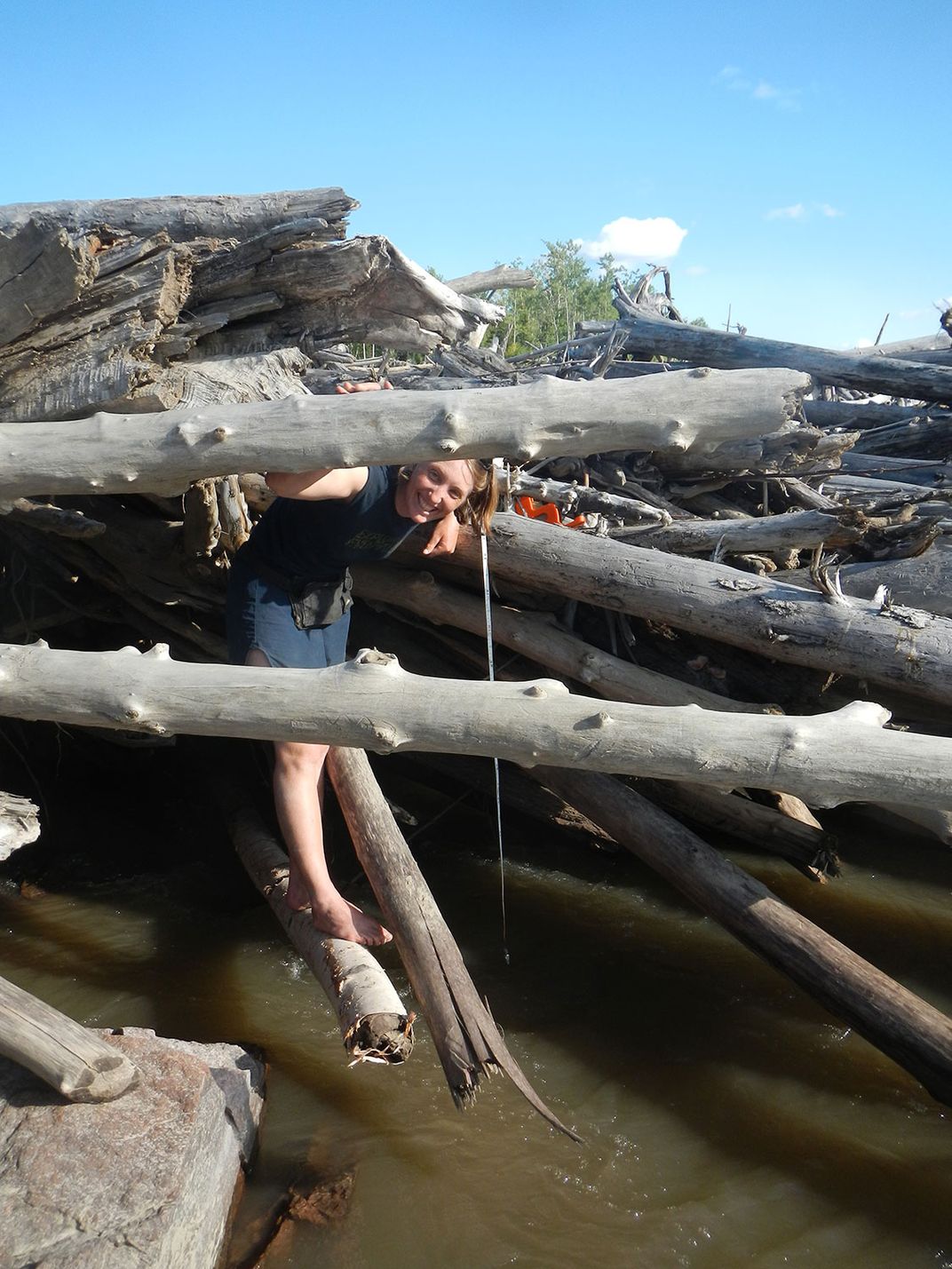
Though beachcombing’s a sunset industry, for Hammond and Moore, it remains worth doing; worth putting to use the hard-won knowledge and skills, feeling the connections to this place and their past. Both men are obliged to take other part-time work, but find their greatest source of professional satisfaction—and identity—out here, on the water, finding and rounding up logs.
**********
The beachcombers of British Columbia are not alone in their attraction to driftwood. Natalie Kramer has spent the past seven summers paddling among the remains of fallen and floating trees in Canada’s Northwest Territories, 1,400 kilometers north of Gibsons. Kramer is a 32-year-old fluvial geomorphologist, a scientist who studies rivers. And, with an impressive list of epic river descents and elite competitions behind her, she also happens to be one of the top pro female kayakers in the world
Kramer’s PhD in wood transport dynamics focused on the Slave River, which flows north into Great Slave Lake, which in turn flows into the Mackenzie River, which in turn flows into the Arctic Ocean. In North America, only the Mississippi drainage basin is larger. Relatively undisturbed by large-scale industrial development, the Mackenzie River system functions much as it has for millennia, making it a natural laboratory for studying the long-term effects of driftwood and its relationship with marine and riverine ecosystems.
To Kramer, rivers are the lifeblood of the planet, and driftwood the nutrients in that blood, an analogy that came to life for her in 2011, when she watched a huge, continuous mass of logs go floating past her base on the bank of the Slave River for three consecutive days.
“That’s when I was like, oh, this is a lot of material!” she exclaims. “It’s a major component of the landscape many people take for granted.”
Kayakers travel the Slave River amid driftwood. Video by Natalie Kramer
One day, Kramer happened upon a massive logjam on the river—the same logjam described in explorer Alexander Mackenzie’s journal in 1789. She cored a tree growing out of the jam itself and found it was over 50 years old.
Immense logjams and floating rafts of naturally occurring wood were once common and well-documented features in rivers and estuaries before they were cleared for navigation. The Great Raft on Louisiana’s Red River, perhaps the most famous, existed for an estimated 375 years before its removal in 1830. The raft and associated jams blocked 227 kilometers of the main channel and stretched approximately twice as far.
Kramer’s research shows that driftwood serves as building blocks for stable sand dunes and spits in estuaries, providing an important buffer from rising tides and waves. But shorelines around the world—especially in developed, temperate zones—are now severely wood impoverished compared to their condition before human settlement. As rivers lose driftwood, water travels through faster and there is less time for nutrient cycling. Excess nitrogen, mostly from agriculture, is one contributor to algal blooms in the marine environment. In wood-starved rivers, there is less opportunity for nitrogen to get reprocessed before being flushed out to sea.
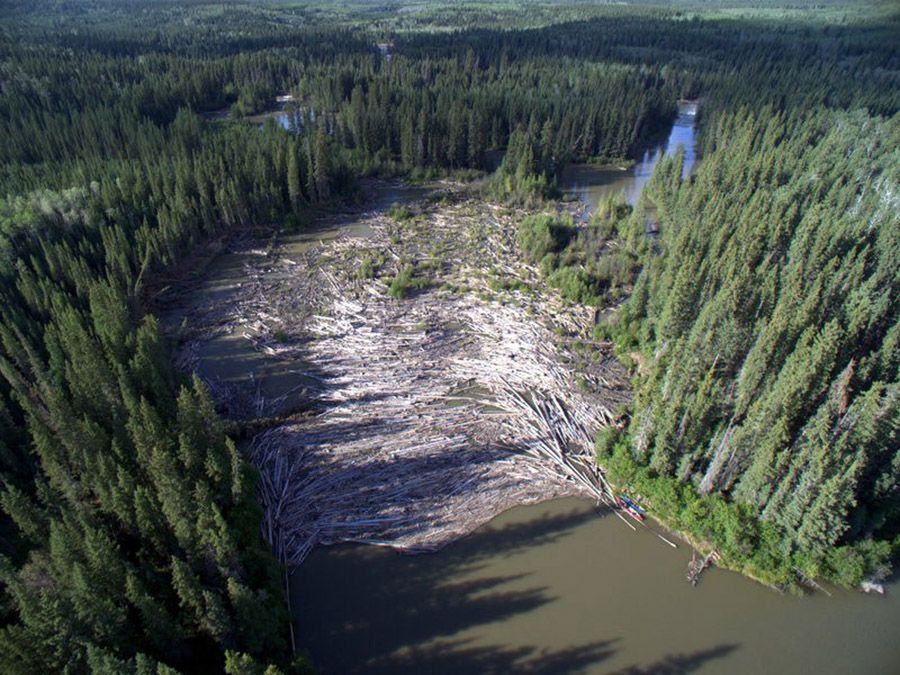
“With the wood gone, our rivers are simpler, less complex, and offer a lot less buffering capacity against contamination and sea level rise,” she says. “The simpler they are, the less resilient they are to change.”
Although her PhD project is now complete, Kramer still paddles the rivers of the Northwest Territories and still has unanswered questions. Like, how much longer will the Slave River run free?
“This river is under threat from hydropower development, and when you build hydropower you block your wood.” She points out that the threat comes not just from proposed development on the Slave itself, but also from the approved Site C dam farther upstream on the Peace River. “If that wood is no longer being delivered to the delta, what do we stand to lose?”
**********
The Mackenzie River system exports large volumes of driftwood into the Arctic Ocean, where it gets frozen into or rafted on sea ice. The sea ice can become caught in the Beaufort Gyre (a clockwise current) before it melts or otherwise shrugs off its cargo. Driftwood then finds its way to distant shores far beyond the tree line. By studying the amount and distribution of driftwood in the Arctic, researchers have learned more about changing ocean currents, sea ice extent, and climate over the past 12,000 years.
Long before driftwood caught the eye of environmental scientists, Arctic people had a primordial relationship with the wood arriving from a forested world they could scarcely imagine. They transformed this precious resource into everything from shelter and weapons to carved, tactile maps that could be read by hand. So valuable was this gift from the sea, archaeologists have speculated that when Inuit ancestors migrated from Alaska to the east over 1,000 years ago, they carried driftwood with them.
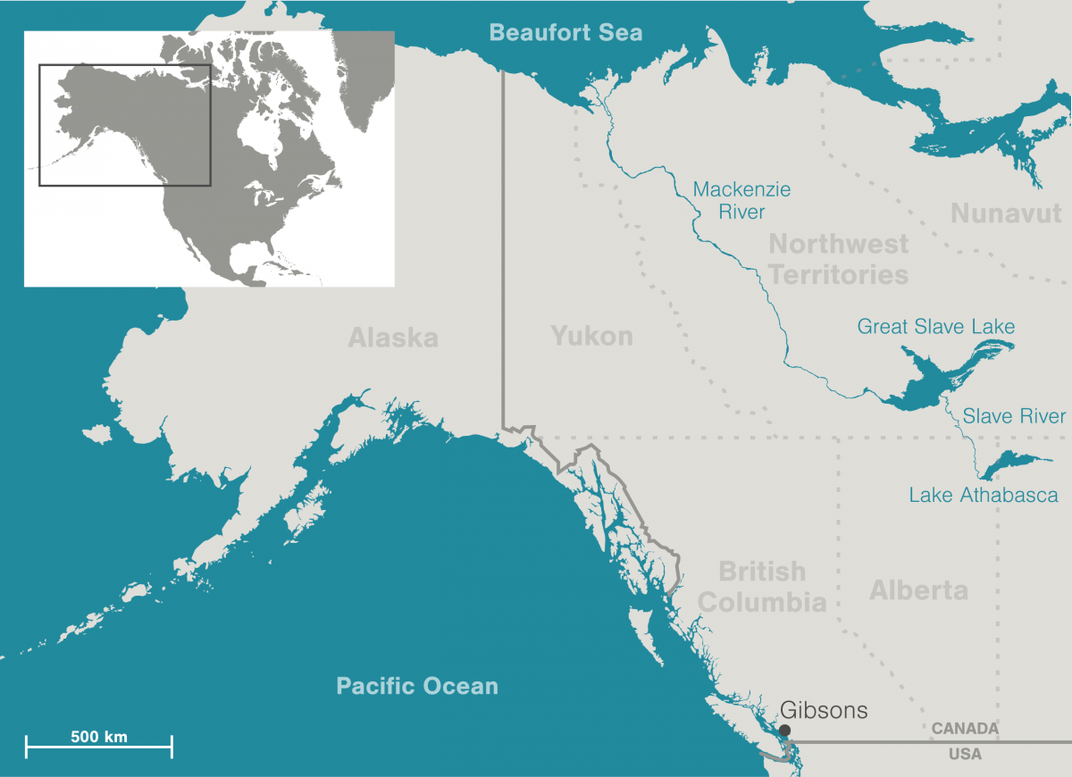
The Inuit are not the only Indigenous people who relied on the bounty of distant forests. The wood flowing from the rivers of the Pacific Northwest also shows up in some surprisingly far-off places. Driftwood that escapes inshore tidal currents can get caught in the North Pacific Gyre, which pulls it far to the west. In the subarctic tundra of southwest Alaska, where the vegetation runs from moss to stunted willow, the Yupik have chants, songs, and stories about the importance of driftwood. Driftwood sheltered them in their qasgiq and ena(men’s and women’s houses), warmed and illuminated their nights, and helped invoke the spirit world through its transformation into exquisitely carved shamanic masks. On the treeless Aleutian Islands, between the Alaskan mainland and Siberia, the Unangan people carved and bent yellow cedar from the Pacific Northwest into incomparable baidarkas—precursors of the modern kayaks Kramer uses in her research and competition today.
Far to the south, logs from the Pacific Northwest once made up the majority of wood washing ashore in the Hawai‘ian Islands. Wood from tropical forests in the Philippines, Malaysia, and Japan also arrived, but the Hawai‘ian people chose Douglas fir and coastal red cedar from over 4,000 kilometers away to integrate into the customs and rituals of their culture. They prized the wood from temperate coastal rainforests for building their large double canoes—symbols of wealth, prestige, and power.
Most driftwood, of course, goes untouched by human hands. The afterlife of these dead trees can be just as surprising.
**********
The fate of most driftwood ultimately awaits at the bottom of the sea. But as researchers like Kramer work to advance our understanding of the dynamic force of logs careening down rivers and streams, less is being added to our knowledge about the role it plays in the marine food web. Pioneering research was conducted on that part of the story by Ruth Dixon Turner during the 1970s–1990s, and later compiled by James Sedell, a leading US Forest Service research scientist and director of fish conservation at the National Fish and Wildlife Foundation. Sedell was intrigued by the disappearance of driftwood from the beaches of the Oregon coast, where he roamed as a boy.
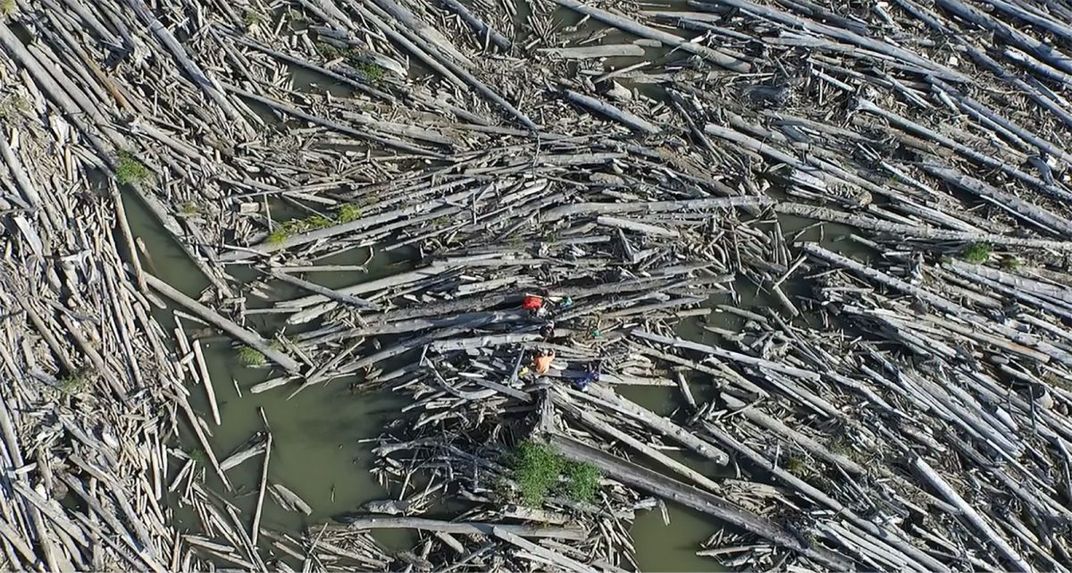
Driftwood can remain afloat in the open ocean, depending on species, for up to 17 months. During that time, these unrooted trees transmute into floating reefs, drifting habitat for a wide range of marine species, including the wingless ocean strider, the only insect known to live in the open ocean. Ocean striders attach their eggs to driftwood even as gribbles (a kind of crustacean) and shipworms (a bivalve mollusk)—the bane of early explorers—consume it from within.
In From the Forest to the Sea: The Ecology of Wood in Streams, Rivers, Estuaries, and Oceans, Sedell and his coauthor Chris Maser explain that over 100 species of invertebrates and 130 species of fish are known to congregate on and around floating objects like driftwood. They do so because of Langmuir currents, pairs of counterrotating convection currents generated by surface winds, which sweep floating logs and organic debris into long, parallel rows often called “slicks.” This in turn attracts plankton and small fish, which in turn draws larger, predatory fish such as dorado, tuna, and sharks. Shade, abundance of food, a place to lay eggs, and protection from waves are among the reasons scientists suspect these temporary environments are so attractive to marine life. It is estimated that, in the habitat associated with a single large piece of oceangoing driftwood, the combined weight of the associated tuna alone can add up to as much as 100 tonnes—or the equivalent of well over half a million cans of tuna.
Tuna are known to time their migration to the continental shelf for spawning with the beginning of the monsoon season. In the eastern Pacific, driftwood carried by the resulting floods arrives just as young yellowfin tuna are emerging from their eggs. Juvenile yellowfin associate with large driftwood and researchers suspect this relationship is important in determining whether or not they’ll reach reproductive age. In the western and tropical Pacific, the tuna fishery went from minuscule to the world’s largest (in terms of total catch) within a decade of recognizing that tuna school around large collections of driftwood—and then seeking out this bait. In the late 1990s, Spanish fishers in the eastern Atlantic even began to enhance natural driftwood with artificial logs to attract more tuna.
For ocean-going driftwood, the journey ends far from where it all began. After a life lived rooted to the land, turning sunshine into energy among insects and birds, after enriching and reshaping rivers and streams, after sheltering and feeding plankton and fish along the surface of the sea, the remains of trees that do not wash ashore sink to the bottom. This submerged wood is most abundant off the estuaries and shores of forested coastlines, but dredging frequently digs up logs in the deep ocean floor and even in deep-sea trenches.
Deep-sea wood borers (Xylophaga, a genus of bivalve mollusks) take over where shallow water gribbles and shipworms left off. These creatures depend on driftwood for survival. They rapidly convert wood into fecal pellets, which in turn support more than 40 species of other deep-sea invertebrates, creating a temporary but productive habitat on the ocean floor, what Sedell called “an island of biodiversity.” Twenty-three years ago, he worried about the decreasing amount of driftwood and the increasing amount of plastic taking its place in the world’s oceans.
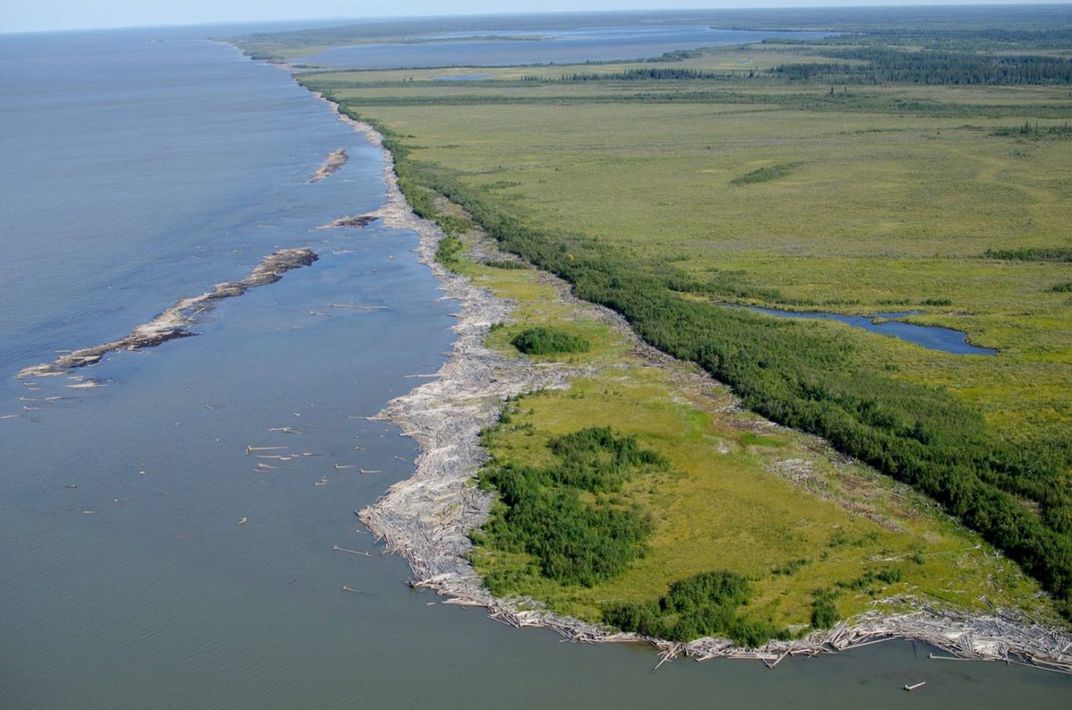
Studies off the coast of Washington State in the late 1990s suggest a rich and vital relationship between the forest and marine environments. Researchers found the amount of organic terrestrial carbon (wood debris and soil from forested rivers and streams) was high, and that dead trees are a significant source of energy in the ecosystem of the ocean floor. How much? Upward of 60 percent of the total organic carbon in shallow coastal waters and about a third in waters up to a kilometer deep. Even at depths beyond that of the Grand Canyon—far off shore—as much as 15 percent of the total organic carbon was byproducts of driftwood.
On the coast of British Columbia, Hammond and Moore recall the late 1990s as being the heyday for log salvaging. Although today’s pickings and profit are comparably slim, Moore says he’ll keep beachcombing as long as he’s able. Will Hammond be the last beachcomber on this stretch of the coast? He shrugs, but points to the half-dozen logs tied to a float in front of his house—all hauled in by his seven-year-old son.
**********
Almost 150 kilometers south of the Hammond family float, a series of explosions between 2011 and 2014 released the Elwha River on its course to the Salish Sea. The US National Park Service destroyed a pair of old hydroelectric dams on Washington State’s Olympic Peninsula, initiating the largest dam removal project in US history. While many people are aware that removing a dam can help clear the way for returning salmon, few realize it frees wood to reach the sea.
The dams were in place for just over a century. During that time, the river was not fully alive, according to Robert Elofson, former director of the river restoration project for the Lower Elwha Klallam Tribe and current fisheries harvest manager.
“You had higher water temperatures in the summer. No woody debris transport, no sediment transport. Now the wood is doing exactly as predicted,” he says, providing food and habitat for insect nymphs and larvae that in turn become food for salmon.
The removal of the Elwha Dam and Glines Canyon Dam restored over 70 kilometers of spawning habitat—habitat once again shaped in part by floating wood. The river is producing salmon again: sockeye, pink, chum, steelhead, coho, and chinook. Birds perch on beached logs and fertilize the soil at the water’s edge. Seeds get trapped and new shoots sprout as other creatures move in. Young fish hide and adult fish rest in the new back eddies and shadows along the shore. The river system, far more complex and diverse, is free to flow along its original course for the first time in living memory.
The rapid rebirth of the Elwha is precisely why Kramer worries about any plans to dam the Slave: it would be a shock felt far beyond the river system. Like Sedell before her, Kramer hopes to wake people up to the need to better understand the vital role of waterborne wood before it’s gone—like the immense log jams and floating rafts of centuries past. Part of that work lies in reimagining the boundaries between words like river, tree, and sea.
Related Stories from Hakai Magazine: